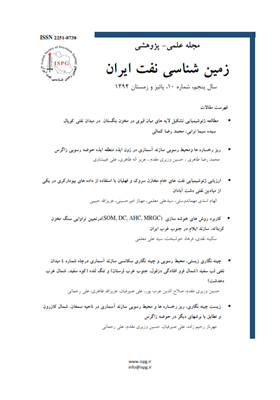مطالعه ژئوشميايي تشکيل ميان لايه هاي قيري در مخزن بنگستان در ميدان نفتي کوپال
محورهای موضوعی :
1 - دانشگاه آزاد اسلامی
کلید واژه: ميان لايه هاي قيري مخزن بنگستان ميدان نفتي کوپال ژئوشيمي مخزن ,
چکیده مقاله :
تاقديس کوپال در حدود 60 کيلومتري شمال شرقي شهرستان اهواز، که از دو کوهانک شرقي و غربي تشکيل شده است. بر اساس مطالعات ژئوشيميايي صورت گرفته بر روي سنگ منشاء ميتوان بيان نمود که سازند پابده در اين ميدان در ابتداي پنجره نفت زايي (Oil-window) قرار دارد. سازند کژدمي در اين ميدان حفاري نشده و براي ارزيابي پختگي و تطابق ژئوشيميايي اين سازند با نفت ميدان کوپال از نمونه هاي سازند کژدمي در چاه هاي ميادين مجاور يعني مارون و هفتگل استفاده شده است؛ نتايج نشان ميدهد اين سازند به عنوان سنگ منشاء اصلي محسوب ميشود. با توجه به اين که در مخزن سروک ميدان کوپال ميان لايه هاي قيري مشاهده شده است، هدف بررسي ژئوشيميايي بر روي ميان لايه هاي قيري در مخزن سروک و علل تشکيل آن در ميدان کوپال مي باشد. نتايج نشان مي دهد که تشکيل ميان لايه هاي قيري در سطح تماس آب و نفت در اثر عوامل مختلفي از جمله آسفالتين گيري طبيعي(Natural Deasphaltening)، جدايش ثقلي (Gravity Segregation) و مخلوط شدن نفت ها(oil-mixing) ايجاد شده است. آناليز هاي ژئوشيميايي دلالت بر آن دارد که آسفالتن اوليه که از سنگ منشاء ايجاد مي شود در نفت وجود ندارد بلکه آسفالتن ثانويه است که به علت فعل و انفعالات شيميايي درون چاهي و به واسطه مخلوط شدن نفت هاي توليدي حاصل از لايه هاي مختلف از هر چاه ايجاد مي گردد
Kupal anticline is elongated and almost symmetric. This structure is located in Northwest of Ahwaz city and consists of two reservoir including Bangestan and Asmari. Kazhdumi, Pabdeh and Gurpi formations are probable source rocks and Gachsaran Formation constitutes the cap rock. Because project topic is defined on Bangestan Group, so reservoir studies of Bangestan is focused on Sarvak Formation. Rock-Eval and geochemical analyses conducted on source rocks indicated that Pabdeh Formation is at early stage of oil generation window in the Kupal oil field. Kazhdumi Formation has not been drilled at this field, so geochemical and maturity assessment of this formation has been evaluated using samples from adjacent oil fields including Marun and Haftgel. Geochemical analyses indicated that Kazhdumi Formation is mature enough and is considered to be the main source rock. The aim of this project is investigating Tar-mat in Bangestan reservoir in Kupal field. It is thought that Tar-mat layer was formed in vicinity of oil-water contact and can be related to processes including natural deasphaltening, gravity segregation and oil-mixing. Based on Rock-Eval pyrolysis, pyrolysis-GC performed on Sarvak oil, it is suggested primary asphaltene formed from source rock does not exist in the studied oil but it is derived from secondary asphaltene by chemical reactions occurring due to oil-mixing in production well. In addition, analysis performed on asphaltene in oil zone, oil-water contact and water zone suggest that Tar-mat was formed in oil water contact region due to oxidation process. This layer acts as impermeable seal and prevents water flow to oil
منابع
[1] آقا نباتي،علي.، 1383، زمين شناسي ايران، انتشارات سازمان زمين شناسي و اکتشافات معدني کشور.#
[2] اشکان،ع. م.، 1383، مطالعات ژئوشيميايي مخزن بنگستان، مشخص نمودن سنگ هاي منشا و همچنين عامل تشکيل و توسعه آسفاتين در ميدان نفتي کوپال، پروژه پژوهشي شرکت ملي مناطق نفت خيز جنوب.#
[3] حسن زاده، ق.، 1386، بررسي ژئوشيميايي علل تشکيل TAR-MAT در ميدان نفتي کوپال ، دومين کنگره مهندسي نفت ايران.#
[4] شايسته، م.، 1383، گزارش نهايي پروژه مطالعات ژئوشيميايي ميدان نفتي کوپال ، شرکت مهندسي زمين و معدن خوزستان. #
[5] صمصامي، ج.، 1391، بررسي ژئوشيميايي علت سنگين شدن نفت مخزن سروک در ميدان نفتي آزادگان، پايان نامه کارشناسي ارشد، دانشگاه شهيد چمران اهواز.#
[6]کمالي، م. ر.، شايسته، م.، 1391، ژئوشيمي نفت مطالعات موردي از ميادين جنوب غرب ايران، انتشارات پژوهشگاه صنعت نفت.#
[7] مطيعي، ه.، 1374، چينه شناسي زاگرس ، انتشارات سازمان زمين شناسي .#
[8] مطيعي، ه.،1389، مقدمه اي بر ارزيابي مخازن نفتي زاگرس، انتشارات آرين زمين.#
[9]BORDENAVE, M., and BURWOOD, R., 1995, The Albian Kazhdumi Formation of Dezful Embayment, Iran: One of the most efficient petroleum generating systems In: Katz, B. J., )eds.(: petroleum source rocks, Springer verlag, Heidelberg.#
[10] BORDENAVE, M. L., and BURWOOD, R., 1990, Source rock distribution and Maturation in the Zagros Orogenic Belt: Provenance of the Asmari and Bangestan reservoir oil accumulations: Organic Geochemistry, 16, 369-387.#
[11] BORDENAVE, M. L., and HEGRE, J. A., 2005, The influence of tectonics on the entrapment of oil in the Dezful Embayment, Zagros Foldbelt, Iran: Journal of Petroleum Geology, 28, 339-368.#
[12] LESS, G. M., 1940, Geology of oil field belt of SW Iran and Iraq: Geology Magazine, 68, 227-252.#
[13] PETERS, K. E., and FOWLER, G. F., 2002, Application of petroleum geochemistry to exploration and reservoir management: Organic Gheochemistry, 33, #5-36
[14] Sherkati, S., Letouzey, J., 2004, Variation of structural style and basin evolution in the central Zagros (Izeh zone and Dezful embayment), Iran: Mar Pet Geol, 21, 535–554#
[15] Waples, D. W., 1985, Geochemistry in petroleum exploration: International Human Resources Development Corporation, Boston. #

